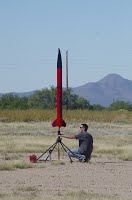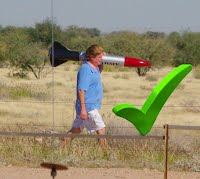 All these steps include the following important note;
All these steps include the following important note;
HAVE FUN!
Step 1: Decide you want to take the step of certifying as a High Power Flier.
- This is the gateway to other certification levels
- This gives you the ability to fly larger rockets, using larger engines and both of those = MORE FUN!
- It is nothing to be intimidated by, everyone launched their first High Power Rocket at some point and we are all willing to help! That leads to step 2.
- In planning and building your first Level 1 capable rocket, you will understand building techniques, rocket dynamics, and safety protocols in a new light. Level 1 rockets are much heavier than sport models, and there is a lot of power in a Level 1 motor, so how your rocket flies and recovers truly matters!
Step 2: Join a club and an organization!
Now you need a place to attempt the flight, and a community to support you. That is where SARA comes in!
Join SARA
- You also need to be insured, since you are flying bigger rockets in a controlled environment, you need to be a member of the National Association of Rocketry (NAR) or Tripoli (TRA). These organizations also provide support and will give you your certification card to buy engines. Critically, they provide insurance for members who abide by the safety code. Both are great and SARA is affiliated with both. Key differences between these organizations are:
-
- If you want to eventually experiment with making your own engines, Tripoli is the place for that.
- If you also want to compete in low power competition, NAR is your organization.
- Tripoli's Junior (under 18) certification program starts at 12 years old.
- NAR allows Juniors to certify to fly high power at 14 years old.
- From a practical perspective, there are more NAR members in SARA who can mentor and approve your certification. If you need to certify with TRA, you will need to coordinate more closely with the Tripoli Prefect.
Step 3: Review the safety codes. These are our guiding lights and are observed at all SARA launches. These set expectations and responsibilities for fliers at the field.
Step 4: Mentor program. Now you will need someone to oversee your launch, at SARA we understand that there are many questions you may have prior to certification day. That is why you should get a mentor, a mentor can help with questions about engine selection, kit selection and construction. In many cases you have a rocket that will be suitable already in your fleet!
Step 5: Read our resident super certification specialist Art Just. This article is fantastic and will help with the steps below.
Step 6: Plan your build using a rocket simulation program. You can simulate flights on different engines and make sure its stable. Art's article mentions the differences between the two programs.
Remember that at SARA's launch site, our ceiling is usually 6,500 feet above ground level, so don't choose a skinny dart of a rocket that will soar above our ceiling. SARA (and you!) will get in trouble, and you likely won't see your model again. Low and Slow is more spectacular anyway, so shoot for something under 3000 feet for your certification flight, so you have an easy time recovering your model. Plan for motors you might want to fly to higher altitudes in the future when calculating your model's center of pressure/center of gravity relationship; bigger motors will be heavier, so they will destabilize your rocket by moving the center of gravity backwards. Plan ahead to keep your options open.
Step 7: Buy neat things! After consulting with your mentor or if you are confident in research you have done.
- HAZMAT Shipping: You will need to buy an engine to certify--only one. Once you are Level 1 certified, you may purchase as many motors as your wallet will bear. However, high power motors must be using HAZMAT ground shipping, which costs extra. You can work with your mentor or other SARA members to be included in one of their orders and share the fee, or you can buy during a vendor's site visit without shipping or just pay the approximately $30+ HAZMAT shipping surcharge.
Step 8: Build your rocket (If needed). Need help?
- Work with your mentor
- Build it strong, don't push limits, and if in doubt, set the epoxy down and ask your mentor.
- Reference tips from Art Just
- Use rocketry forums, many people can help with your build, you can also search for your question and see if someone already answered it
-

Step 9: Plan a date! If you do not have a mentor yet, email members@sararocketry.org that you would like to Level 1 and pick a launch date http://www.sararocketry.org/events
- Someone will email you back and let you know where to find them at the launch.
- Download and print the application off NAR or TRA websites.
- Make sure you have read the safety code and can answer questions about your rocket.
Step 10: Launch!
- Meet with your mentor, and be prepared to show him how you built your
 rocket and assembled your motor. You'll need to show the center of pressure and the center of gravity with the motor installed.
rocket and assembled your motor. You'll need to show the center of pressure and the center of gravity with the motor installed. - Set the rocket up on the pad.
- Grab a camera! A GoPro a few feet from the pad, looking up captures awesome footage.
- 5.4.3.2.1 Launch!
- If you can recover the rocket safely in a condition that can fly again with a new engine and no repairs, you are Certified!
- Send in the application, and you will get a new card, you are now official!